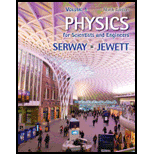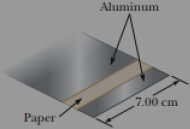
Physics for Scientists and Engineers, Volume 1
9th Edition
ISBN: 9781133954156
Author: Raymond A. Serway
Publisher: CENGAGE L
expand_more
expand_more
format_list_bulleted
Concept explainers
Textbook Question
Chapter 26, Problem 26.46P
A commercial capacitor is to be constructed as shown in Figure P25.27. This particular capacitor is made from two strips of aluminum foil separated by a strip of paraffin-coated paper. Each strip of foil and paper is 7.00 cm wide. The foil is 0.004 00 mm thick, and the paper is 0.025 0 mm thick and has a dielectric constant of 3.70. What length should the strips have if a capacitance of 9.50 × 10−8 F is desired before the capacitor is rolled up? (Adding a second strip of paper and rolling the capacitor would effectively double its capacitance by allowing charge storage on both sides of each strip of foil.)
Figure P25.27

Expert Solution & Answer
Trending nowThis is a popular solution!

Students have asked these similar questions
Three moles of an ideal gas undergo a reversible isothermal compression at 20.0° C. During this compression,
1900 J of work is done on the gas.
For related problem-solving tips and strategies, you may want to view a Video Tutor Solution of
Entropy change in a free expansion.
Part A
What is the change of entropy of the gas?
ΤΕ ΑΣΦ
AS =
Submit
Request Answer
J/K
5.97 Block A, with weight
3w, slides down an inclined plane
S of slope angle 36.9° at a constant
speed while plank B, with weight
w, rests on top of A. The plank
is attached by a cord to the wall
(Fig. P5.97). (a) Draw a diagram
of all the forces acting on block
A. (b) If the coefficient of kinetic
friction is the same between A and
B and between S and A, determine
its value.
Figure P5.97
B
A
S
36.9°
Please take your time and solve each part correctly please. Thank you!!
Chapter 26 Solutions
Physics for Scientists and Engineers, Volume 1
Ch. 26 - A capacitor stores charge Q at a potential...Ch. 26 - Many computer keyboard buttons are constructed of...Ch. 26 - Two capacitors are identical. They can be...Ch. 26 - You have three capacitors and a battery. In which...Ch. 26 - If you have ever tried to hang a picture or a...Ch. 26 - A fully charged parallel-plate capacitor remains...Ch. 26 - By what factor is the capacitance of a metal...Ch. 26 - An electronics technician wishes to construct a...Ch. 26 - A parallel-plate capacitor is connected to a...Ch. 26 - If three unequal capacitors, initially uncharged,...
Ch. 26 - Assume a device is designed to obtain a large...Ch. 26 - (i) What happens to the magnitude of the charge...Ch. 26 - A capacitor with very large capacitance is in...Ch. 26 - A parallel-plate capacitor filled with air carries...Ch. 26 - (i) A battery is attached to several different...Ch. 26 - A parallel-plate capacitor is charged and then is...Ch. 26 - (i) Rank the following five capacitors from...Ch. 26 - True or False? (a) From the definition of...Ch. 26 - You charge a parallel-plate capacitor, remove it...Ch. 26 - (a) Why is it dangerous to touch the terminals of...Ch. 26 - Assume you want to increase the maximum operating...Ch. 26 - If you were asked to design a capacitor in which...Ch. 26 - Prob. 26.4CQCh. 26 - Explain why the work needed to move a particle...Ch. 26 - An air-filled capacitor is charged, then...Ch. 26 - The sum of the charges on both plates of a...Ch. 26 - Because the charges on the plates of a...Ch. 26 - (a) When a battery is connected to the plates of a...Ch. 26 - Two conductors having net charges of +10.0 C and...Ch. 26 - (a) How much charge is on each plate of a 4.00-F...Ch. 26 - An air-filled parallel-plate capacitor has plates...Ch. 26 - A 50.0-in length of coaxial cable has an inner...Ch. 26 - (a) Regarding (lie Earth and a cloud layer 800 m...Ch. 26 - When a potential difference of 150 V is applied to...Ch. 26 - Prob. 26.8PCh. 26 - An air-filled capacitor consists of two parallel...Ch. 26 - A variable air capacitor used in a radio tuning...Ch. 26 - An isolated, charged conducting sphere of radius...Ch. 26 - Review. A small object of mass m carries a charge...Ch. 26 - Two capacitors, C1 = 5.00 F and C2 = 12.0 F, are...Ch. 26 - What If? The two capacitors of Problem 13 (C1 =...Ch. 26 - Find the equivalent capacitance of a 4.20-F...Ch. 26 - Prob. 26.16PCh. 26 - According to its design specification, the timer...Ch. 26 - Why is the following situation impossible? A...Ch. 26 - For the system of four capacitors shown in Figure...Ch. 26 - Three capacitors are connected to a battery as...Ch. 26 - A group of identical capacitors is connected first...Ch. 26 - (a) Find the equivalent capacitance between points...Ch. 26 - Four capacitors are connected as shown in Figure...Ch. 26 - Consider the circuit shown in Figure P26.24, where...Ch. 26 - Find the equivalent capacitance between points a...Ch. 26 - Find (a) the equivalent capacitance of the...Ch. 26 - Two capacitors give an equivalent capacitance of...Ch. 26 - Two capacitors give an equivalent capacitance of...Ch. 26 - Consider three capacitors C1, C2. and C3 and a...Ch. 26 - The immediate cause of many deaths is ventricular...Ch. 26 - A 12.0-V battery is connected to a capacitor,...Ch. 26 - A 3.00-F capacitor is connected to a 12.0-V...Ch. 26 - As a person moves about in a dry environment,...Ch. 26 - Two capacitors, C1 = 18.0 F and C2 = 36.0 F, are...Ch. 26 - Two identical parallel-plate capacitors, each with...Ch. 26 - Two identical parallel-plate capacitors, each with...Ch. 26 - Two capacitors, C1 = 25.0 F and C2 = 5.00 F, are...Ch. 26 - A parallel-plate capacitor has a charge Q and...Ch. 26 - Review. A storm cloud and the ground represent the...Ch. 26 - Consider two conducting spheres with radii R1 and...Ch. 26 - Review. The circuit in Figure P26.41 (page 804)...Ch. 26 - A supermarket sells rolls of aluminum foil,...Ch. 26 - (a) How much charge can be placed 011 a capacitor...Ch. 26 - The voltage across an air-filled parallel-plate...Ch. 26 - Determine (a) the capacitance and (b) the maximum...Ch. 26 - A commercial capacitor is to be constructed as...Ch. 26 - A parallel-plate capacitor in air has a plate...Ch. 26 - Each capacitor in the combination shown in Figure...Ch. 26 - A 2.00-nF parallel-plate capacitor is charged to...Ch. 26 - A small rigid object carries positive and negative...Ch. 26 - An infinite line of positive charge lies along the...Ch. 26 - A small object with electric dipole moment p is...Ch. 26 - The general form of Gausss law describes how a...Ch. 26 - Find the equivalent capacitance of' the group of...Ch. 26 - Four parallel metal plates P1, P2, P3, and P4,...Ch. 26 - For (he system of four capacitors shown in Figure...Ch. 26 - A uniform electric field E = 3 000 V/m exists...Ch. 26 - Two large, parallel metal plates, each of area A,...Ch. 26 - A parallel-plate capacitor is constructed using a...Ch. 26 - Why is the following situation impossible? A...Ch. 26 - Prob. 26.61APCh. 26 - A parallel-plate capacitor with vacuum between its...Ch. 26 - A 10.0-F capacitor is charged to 15.0 V. It is...Ch. 26 - Assume that the internal diameter of the...Ch. 26 - Two square plates of sides are placed parallel to...Ch. 26 - (a) Two spheres have radii a and b, and their...Ch. 26 - A capacitor of unknown capacitance has been...Ch. 26 - A parallel-plate capacitor of plate separation d...Ch. 26 - Prob. 26.69APCh. 26 - Example 25.1 explored a cylindrical capacitor of...Ch. 26 - To repair a power supply for a stereo amplifier,...Ch. 26 - The inner conductor of a coaxial cable has a...Ch. 26 - Some physical systems possessing capacitance...Ch. 26 - Consider two long, parallel, and oppositely...Ch. 26 - Determine the equivalent capacitance of the...Ch. 26 - A parallel-plate capacitor with plates of area LW...Ch. 26 - Calculate the equivalent capacitance between...Ch. 26 - A capacitor is constructed from two square,...
Knowledge Booster
Learn more about
Need a deep-dive on the concept behind this application? Look no further. Learn more about this topic, physics and related others by exploring similar questions and additional content below.Similar questions
- help me answer this with explanations! thanks so mucharrow_forwardNo chatgpt pls will upvote Alreadyarrow_forwardWhat fuel economy should be expected from a gasoline powered car that encounters a total of 443N of resistive forces while driving down the road? (Those forces are from air drag, rolling resistance and bearing losses.) Assume a 30% thermodynamic efficiency.arrow_forward
- No chatgpt pls will upvotearrow_forward12. What is the angle between two unit vectors if their dot product is 0.5?arrow_forwardIf the car in the previous problem increases its power output by 10% (by pressing the gas pedal farther down), at what rate will the car accelerate? Hint: Consider the net force. In the previous problem the power was 31.8kWarrow_forward
- What power is required (at the wheels) for a 1400 kg automobile to climb a 4% grade at a constant speed 30 m/s while it is opposed by drag and rolling resistance forces totaling 500 N?arrow_forwardNo chatgpt pls will upvotearrow_forwardAs a box is lifted against gravity and placed on a shelf, how does the work done by the lifter compare with the work done by gravity? What is the net work done on the box? What does this imply about its change in kinetic energy? Use definitions and mathematics from this chapter to answer these questions.arrow_forward
- As I carry a box up a flight of stairs, am I doing positive work or negative work on the box? Provide a mathematical explanation.arrow_forwardAs a ball falls under the influence of gravity, does gravity do positive work or negative work? Provide a mathematical explanation.arrow_forwardUnder what circumstances is it bad to describe kinetic energy as k = 1/2mv^2arrow_forward
arrow_back_ios
SEE MORE QUESTIONS
arrow_forward_ios
Recommended textbooks for you
 Physics for Scientists and Engineers: Foundations...PhysicsISBN:9781133939146Author:Katz, Debora M.Publisher:Cengage Learning
Physics for Scientists and Engineers: Foundations...PhysicsISBN:9781133939146Author:Katz, Debora M.Publisher:Cengage Learning Physics for Scientists and EngineersPhysicsISBN:9781337553278Author:Raymond A. Serway, John W. JewettPublisher:Cengage Learning
Physics for Scientists and EngineersPhysicsISBN:9781337553278Author:Raymond A. Serway, John W. JewettPublisher:Cengage Learning Physics for Scientists and Engineers with Modern ...PhysicsISBN:9781337553292Author:Raymond A. Serway, John W. JewettPublisher:Cengage Learning
Physics for Scientists and Engineers with Modern ...PhysicsISBN:9781337553292Author:Raymond A. Serway, John W. JewettPublisher:Cengage Learning
 College PhysicsPhysicsISBN:9781285737027Author:Raymond A. Serway, Chris VuillePublisher:Cengage Learning
College PhysicsPhysicsISBN:9781285737027Author:Raymond A. Serway, Chris VuillePublisher:Cengage Learning Principles of Physics: A Calculus-Based TextPhysicsISBN:9781133104261Author:Raymond A. Serway, John W. JewettPublisher:Cengage Learning
Principles of Physics: A Calculus-Based TextPhysicsISBN:9781133104261Author:Raymond A. Serway, John W. JewettPublisher:Cengage Learning

Physics for Scientists and Engineers: Foundations...
Physics
ISBN:9781133939146
Author:Katz, Debora M.
Publisher:Cengage Learning

Physics for Scientists and Engineers
Physics
ISBN:9781337553278
Author:Raymond A. Serway, John W. Jewett
Publisher:Cengage Learning

Physics for Scientists and Engineers with Modern ...
Physics
ISBN:9781337553292
Author:Raymond A. Serway, John W. Jewett
Publisher:Cengage Learning


College Physics
Physics
ISBN:9781285737027
Author:Raymond A. Serway, Chris Vuille
Publisher:Cengage Learning

Principles of Physics: A Calculus-Based Text
Physics
ISBN:9781133104261
Author:Raymond A. Serway, John W. Jewett
Publisher:Cengage Learning
Physics Capacitor & Capacitance part 7 (Parallel Plate capacitor) CBSE class 12; Author: LearnoHub - Class 11, 12;https://www.youtube.com/watch?v=JoW6UstbZ7Y;License: Standard YouTube License, CC-BY